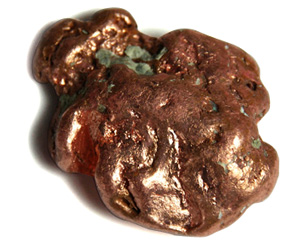Copper
| EPA Secondary Drinking Water Standard |
1 mg/L |

Copper is a reddish naturally occurring metal. In water it is typically dissolved as a divalent cation (Cu +2).
Copper is widely used to make copper pipe and tubing, and copper compounds are used as pesticides and herbicides.
Corrosion from copper plumbing fixtures may cause high levels of copper in drinking water. The presence of copper corrosion is often indicated by blue-green staining of fixtures.
Health Effects of Copper
Copper is a necessary nutrient, but too much copper can cause nausea and vomiting, and long-term exposure can lead to liver damage and kidney problems.
Water Treatment for Copper
Copper can be controlled in whole house (POE) applications and plumbing fixtures protected by cation exchange, pH control, and film-creating compounds such as polyphosphates.
For point of use treatment, reverse osmosis removes copper handily—usually around 97%. Copper can also be removed by distillation and activated carbon adsorption.
Photo source: WikiMedia, author: Jurii
Site Index
Filtration Systems
- Aeration for Iron & Sulfide
- Backwashing Filters
(whole house & well units)
- Chlorine & Chemical Injectors
- Countertop Water Filters
- Emergency Filters
- Garden Hose Filters
- Reverse Osmosis, Residential
- Reverse Osmosis, Commercial
- Shower Filters
- Specialty Filters
- Ultraviolet Systems
- Undersink Filters
- Water Softeners
- Whole House Filters
Cartridges
Parts
- Replacement Parts
- Faucets
- Filter Media
- Fittings
- Housings
- O-rings
- Pumps
- Pura UV
- R.O. Parts
- R.O. Tanks
- R.O. Booster Pump
- VIQUA UV